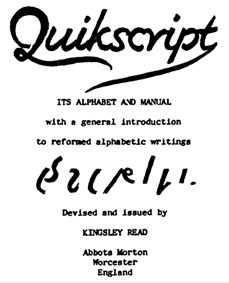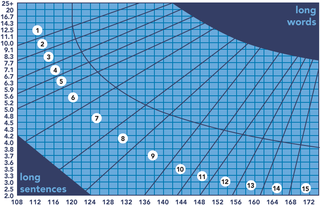
Hyperlexia is a syndrome characterized by a child's precocious ability to read. It was initially identified by Norman E. Silberberg and Margaret C. Silberberg (1967), who defined it as the precocious ability to read words without prior training in learning to read, typically before the age of five. They indicated that children with hyperlexia have a significantly higher word-decoding ability than their reading comprehension levels. Children with hyperlexia also present with an intense fascination for written material at a very early age.

Quikscript is an alphabet which is intended as a replacement for traditional English orthography with the Latin alphabet. It is a compact phonemic orthography, designed to be comfortably and quickly written.
Plain language is writing designed to ensure the reader understands as quickly, easily, and completely as possible. Plain language strives to be easy to read, understand, and use. It avoids verbose, convoluted language and jargon. In many countries, laws mandate that public agencies use plain language to increase access to programs and services. The United Nations Convention on the Rights of Persons with Disabilities includes plain language in its definition of communication.
Readability is the ease with which a reader can understand a written text. The concept exists in both natural language and programming languages though in different forms. In natural language, the readability of text depends on its content and its presentation. In programming, things such as programmer comments, choice of loop structure, and choice of names can determine the ease with which humans can read computer program code.

The Flesch–Kincaid readability tests are readability tests designed to indicate how difficult a passage in English is to understand. There are two tests: the Flesch Reading-Ease, and the Flesch–Kincaid Grade Level. Although they use the same core measures, they have different weighting factors.
In linguistics, the Gunning fog index is a readability test for English writing. The index estimates the years of formal education a person needs to understand the text on the first reading. For instance, a fog index of 12 requires the reading level of a United States high school senior. The test was developed in 1952 by Robert Gunning, an American businessman who had been involved in newspaper and textbook publishing.

In typography, text or font in all caps contains capital letters without any lowercase letters. For example:
THE QUICK BROWN FOX JUMPS OVER THE LAZY DOG.
Words per minute, commonly abbreviated as WPM, is a measure of words processed in a minute, often used as a measurement of the speed of typing, reading or Morse code sending and receiving.

The Fry readability formula is a readability metric for English texts, developed by Edward Fry.
Reading comprehension is the ability to process written text, understand its meaning, and to integrate with what the reader already knows. Reading comprehension relies on two abilities that are connected to each other: word reading and language comprehension. Comprehension specifically is a "creative, multifaceted process" that is dependent upon four language skills: phonology, syntax, semantics, and pragmatics.
The automated readability index (ARI) is a readability test for English texts, designed to gauge the understandability of a text. Like the Flesch–Kincaid grade level, Gunning fog index, SMOG index, Fry readability formula, and Coleman–Liau index, it produces an approximate representation of the US grade level needed to comprehend the text.
The Coleman–Liau index is a readability test designed by Meri Coleman and T. L. Liau to gauge the understandability of a text. Like the Flesch–Kincaid Grade Level, Gunning fog index, SMOG index, and Automated Readability Index, its output approximates the U.S. grade level thought necessary to comprehend the text.
Sentence spacing concerns how spaces are inserted between sentences in typeset text and is a matter of typographical convention. Since the introduction of movable-type printing in Europe, various sentence spacing conventions have been used in languages with a Latin alphabet. These include a normal word space, a single enlarged space, and two full spaces.
Linsear Write is a readability metric for English text, purportedly developed for the United States Air Force to help them calculate the readability of their technical manuals. It is one of many such readability metrics, but is specifically designed to calculate the United States grade level of a text sample based on sentence length and the number of words used that have three or more syllables. It is similar to the Fry readability formula.
The SMOG grade is a measure of readability that estimates the years of education needed to understand a piece of writing. SMOG is an acronym for "Simple Measure of Gobbledygook".
William S. Gray was an American educator and literacy advocate, who was commonly referred to as "The father of Reading".
The Spache readability formula is a readability test for writing in English, designed by George Spache. It works best on texts that are for children up to fourth grade. For older children, the Dale–Chall readability formula is more appropriate.
The Wechsler Individual Achievement Test Second Edition assesses the academic achievement of children, adolescents, college students and adults, aged 4 through 85. The test enables the assessment of a broad range of academics skills or only a particular area of need. The WIAT-II is a revision of the original WIAT, and additional measures. There are four basic scales: Reading, Math, Writing and Oral Language. Within these scales there is a total of 9 sub-test scores.

Reading is the process of taking in the sense or meaning of symbols, often specifically those of a written language, by means of sight or touch.
Indirect memory tests assess the retention of information without direct reference to the source of information. Participants are given tasks designed to elicit knowledge that was acquired incidentally or unconsciously and is evident when performance shows greater inclination towards items initially presented than new items. Performance on indirect tests may reflect contributions of implicit memory, the effects of priming, a preference to respond to previously experienced stimuli over novel stimuli. Types of indirect memory tests include the implicit association test, the lexical decision task, the word stem completion task, artificial grammar learning, word fragment completion, and the serial reaction time task.






